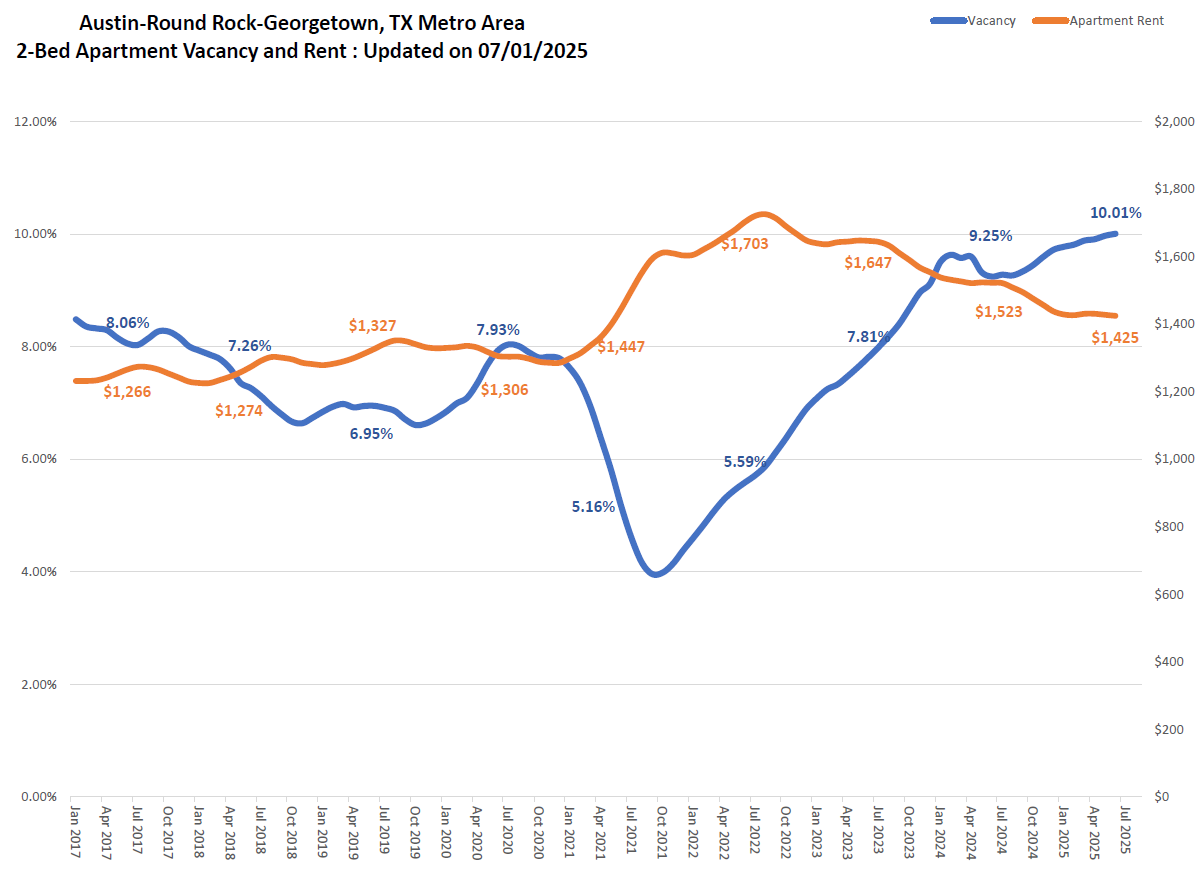Austin’s Apartment Market: Now Among the Top 5 Highest Vacancy Rates in the Nation
Published | Posted by Dan Price
Austin Rents Slide and Vacancy Surges: Multifamily Market Faces Repricing in 2025
Austin’s multifamily housing market is undergoing a significant correction. As of June 2025, the metro area has reached a vacancy rate of 10.01%, placing it among the top five metro areas in the United States for apartment oversupply. At the same time, apartment rents have continued their steady decline, falling to $1,425 from a peak of $1,726 in August 2022—a 17.44% drop in less than three years.
This sharp reversal in market conditions has pushed Austin into fifth place nationally for apartment vacancy, trailing only North Port-Sarasota-Bradenton (12.36%), Cape Coral-Fort Myers (10.61%), Myrtle Beach (10.38%), and Birmingham-Hoover (10.08%). Just two years ago, Austin’s vacancy rate was at 7.81% and falling. In fact, during the post-pandemic surge in demand, the city’s multifamily sector hit a low vacancy of 4.16% in August 2021, pushing rents to record highs as demand outpaced supply. Since then, however, the dynamic has flipped.
This turnaround is being driven by several key factors: a significant wave of new construction hitting the market, a slowdown in household formation due to affordability pressures, and the broader economic impact of higher interest rates. Renters now have more options and greater negotiating power, leading to both longer lease-up periods and softer rent growth—or in Austin’s case, actual rent contraction.
Other Texas metros are feeling the pressure too. San Antonio currently has a vacancy rate of 9.26%, Dallas-Fort Worth sits at 8.66%, and Houston is at 8.46%. All are in the top 30 nationwide for multifamily vacancy, signaling a widespread state-level trend where robust new construction and cooling demand are creating friction across the rental housing market.
One of the more immediate and tangible effects of these shifts is on the valuation of apartment assets, particularly those completed during the 2020–2022 construction boom. Take, for example, a 100-unit multifamily development that was financed in 2020, completed in 2022. When market rents were $1,726 and vacancy was just 4%, that project would have supported a valuation of roughly $33.14 million using the income approach at a 6% cap rate. Now, with rents down to $1,425 and vacancy up to 10%, the same property is likely to be appraised at just $25.65 million—a decline of $7.49 million, or 22.6%.
This isn’t just a paper loss. If the property was financed on a 5-year term, as many are, the refinancing scheduled for 2025 could be a serious challenge. Banks use current income and market cap rates to assess property value. A valuation haircut of this magnitude means many owners will face refinancing gaps, with loan-to-value ratios falling out of compliance. Borrowers may be asked to contribute fresh equity, accept higher interest rates, or—if their financials can’t support the new terms—risk default or sale at a loss.
Across the board, Austin’s multifamily market is showing the strain of overbuilding into a cooling demand cycle. This does not signal a long-term crisis for the city’s fundamentals. Austin remains a high-growth metro with strong tech employment and continued in-migration. But in the near term, the correction is real. The combination of rising vacancies and falling rents is placing real pressure on landlords, investors, and developers alike.
Looking forward, market observers expect rent trends to remain flat or slightly negative through the end of 2025, especially as more inventory continues to deliver. Stabilization will require a combination of slower new starts, steady population growth, and absorption of current supply. Until then, property valuations—especially for projects timed near the peak—will continue to reflect the shifting reality of a softer leasing environment.
Frequently Asked Questions
What is Austin’s current apartment vacancy rate?
As of June 2025, the apartment vacancy rate in the Austin-Round Rock-Georgetown metro area is 10.01%, making it the fifth highest among all U.S. metro areas. This rate has more than doubled from its low point of 4.16% in August 2021.
How much have Austin apartment rents dropped from their peak?
Rents for two-bedroom apartments in Austin peaked at $1,726 in August 2022. As of June 2025, the average rent has declined to $1,425, representing a 17.44% drop over that period.
Why are vacancy rates so high in Austin?
The spike in vacancies is primarily due to a surge in new apartment construction, combined with a slowdown in demand growth. High interest rates, affordability constraints, and greater rental options have led to softer leasing activity and higher unit availability.
What happens to apartment values when rents fall and vacancy rises?
Apartment valuations are based on net operating income, which is sensitive to both rent levels and vacancy rates. When rents fall and vacancy increases, income declines—reducing the property’s appraised value. For example, a 100-unit complex that supported a $33 million valuation at the peak may now appraise at just $25.6 million, a 22.6% drop.
How does this affect multifamily properties coming up for refinance in 2025?
Properties completed in 2022 on 5-year loans are now approaching refinance. With lower rents and higher vacancies, many won’t meet prior loan-to-value benchmarks. Owners may need to inject additional equity or refinance at higher rates with reduced loan proceeds, introducing significant financial stress.

Request Info
Have a question about this article or want to learn more?


